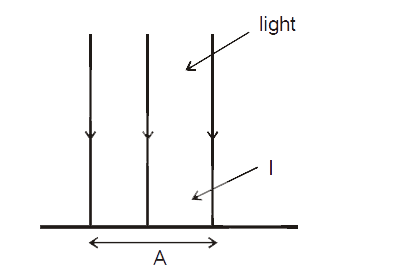A beam of X−rays with wavelength λ=174± falls on the surface of a single crystal rotating about its axis which is parallel let to its surface and perpendicular to the direction of the incident beam. In this case the direction to the maxima of second and third order from the system of planes parallel to the surface of the single crystal from an angle α=60∘ between them. Find the corresponding interplanar disatnce.
When the crystal is roated, the incident monochromatic beam is diffracted from a given crystal plane of interplanar spacing d whenever in the course of rotation the value of θ satisfies the Bragg equation.
We have the equations 2dsinθ1=k1λ and 2dsinθ2=k2λ
But π−2θ1=π−2θ2+α or 2θ1=2θ2−α
so θ2=θ1+α2.
Thus 2d{sin.θ1cos.α2+cosθ1sin.α2}=k2λ
Hence 2dsin.α2cos.θ1=(k2−k1cos.α2)λ
also 2dsin.α2sin.θ1=k1λsin.α2
Squaring and adding 2dsin.α2=(k21+k22−2k1k2cos.α2)1/2λ
Hence d=λ2sin.α2[k21+k22−2k1k2cos.α2]1/2
Substituting α=60∘,k1=2,k2=3,λ=174±
we get d=128±=2.81Å
(and not 0.281± as given in the book)
(Lattice parameters are typically in Å's and not in fractions of a pm.)

Topper's Solved these Questions
- OPTICSBook:IE IRODOV, LA SENA & SS KROTOVChapter:OPTICSExercise:Polarization Of Light
Explore 43 Videos
- OPTICSBook:IE IRODOV, LA SENA & SS KROTOVChapter:OPTICSExercise:Dispersion And Absorption Of Light
Explore 24 Videos
- OPTICSBook:IE IRODOV, LA SENA & SS KROTOVChapter:OPTICSExercise:Interference Of Light
Explore 33 Videos
- MECHANICSBook:IE IRODOV, LA SENA & SS KROTOVChapter:MECHANICSExercise:Mechanics Problems
Explore 92 Videos
- OSCILLATIONS AND WAVESBook:IE IRODOV, LA SENA & SS KROTOVChapter:OSCILLATIONS AND WAVESExercise:Electromagnetic Waves, Radiation
Explore 36 Videos
Similar Questions
A parallel beam of light of wavelength l is incident normally on a narrow slit. A diffraction pattern is formed on a screen placed perpendicular to the direction of the incident beam. At the second minimum of the diffraction pattern, the phase difference between the rays coming from the two edges of slit is
View SolutionA beam of monochromatic light of wavelength λ falls normally on a diffraction grating of line spacing d. If θ is the angle between the second-order diffracted beam and the direction of the incident light, what is the value of sinθ ?
View Solution
Knowledge Check
A beam of monochromatic light of wavelength λ falls normally on a diffraction grating of line spacing d. If θ is the angle between the second-order diffracted beam and the direction of the incident light, what is the value of sinθ ?
AλdBdλC2λdD2dλA parallel beam of monochromatic light is incident on the surface of water having refractive index 4/3. The direction of the incidence beam bisects the angle between the normal to the water surface and the water surface. The angles of incidence and refraction are
Ai=30∘,r=20∘Bi=45∘,r=20∘Ci=45∘,r=32∘Di=60∘,r=40∘If the moment of inertion of a disc about an axis tangentially and parallel to its surface by I, then what will be the moment of inertia about the axis tangential but perpendicular to the surface
A65IB34IC32ID54I
A beam of monochromatic light of wavelength λ falls normally on a diffraction grating of line spacing d. If θ is the angle between the second-order diffracted beam and the direction of the incident light, what is the value of sinθ ?
View SolutionA plane monochromatic light wave with wavelength λ falls on the surface of a glass wedge whose faces from an angle α<<1. The plane of incidence is perpendicualr to the edge, the angle of incidence is θ1. Find the distance between the neighbouring fringe maxima on the screen placed at right angles to reflected light.
View SolutionA beam of X-rays with wavelength λ falls at a glancing angle 60.0∘ on a linear chain of scattering centres with period a. Find the angles of incidence corresponding to all diffraction maxima if λ=2a/5.
View SolutionA beam of light having wavelength λ and intensity 1 falls normally on an area A of a clean surface then
find out the number of photon incident on the surface.

View SolutionA ray of light falls on the surface of a spherical glass paper weight making an angle α with the normal and is refracted in the medium at an angle β. The angle of deviation of the emergent ray from the direction of the incident ray is :
View Solution

